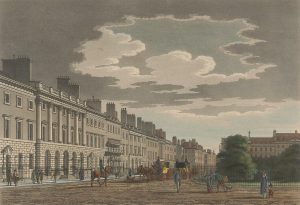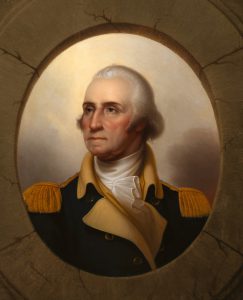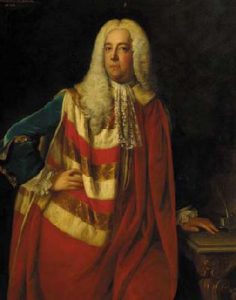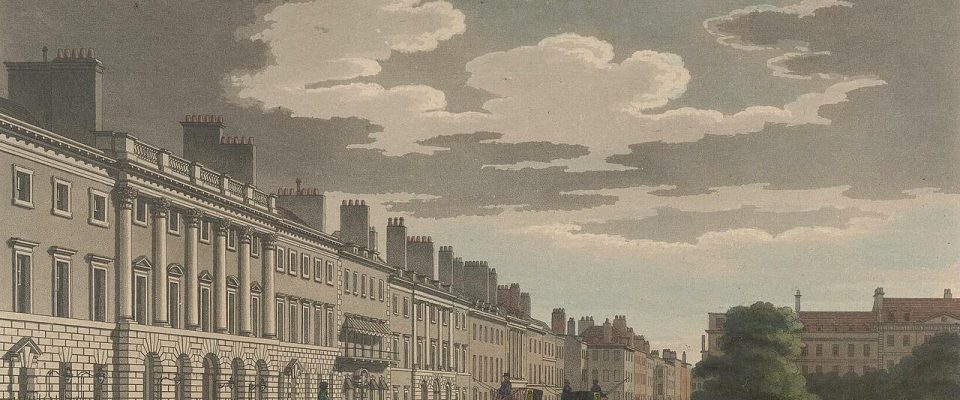By Edward Spannaus
(Part I of this series, updated, may be found here.)
In June 1783, as the Treaty of Paris to end the Revolutionary War was being finalized, the Countess of Tankerville wrote a letter to George Washington from England, granting him Power of Attorney to aid in the disposal of the Tankerville lands in Virginia.

In October that year, General Washington responded to the Countess, informing her that he must decline the trust with which she and the Earl of Tankerville have invested him. “I am not yet returned to Virginia after an absence of almost nine years from My family & home,” Washington wrote, adding that both his private affairs and the affairs of others entrusted to his care were in a “deranged” state. “To recover all these from the disorder into which they have run will be attended with more difficulty & require a much longer time than comports with that ease, & freedom from care, of which I stand very much in need.”
Washington advised the Countess that he had forwarded the Power of Attorney to Edmund Randolph, the Virginia Attorney General, who, he wrote, “no doubt will advice you of his intention, & what further ought to be done.”
Countess Alicia Astley Bennett, also known as the Dowager of Tankerville, was the widow of the 3rd Earl of Tankerville, and the mother of Charles Bennett, the 4th Earl of Tankerville, and also of his brother, Henry Astley Bennett. Her two sons had inherited her husband’s lands in Virginia and Maryland.
But how did such a member of the British nobility happen to be seeking the aid of George Washington, who was still in the service of his country in its war against Great Britain?
Washington’s entangling alliance

The affairs of all British land holdings in America were thrown into confusion during the Revolutionary War, and for a number of years after. This was the context in which Lady Tankerville, and her sons, were asking George Washington for his assistance. The first issue was the sequestration and the threat of complete confiscation of the Tankerville lands during the Revolution, and the second was the matter of establishing clear title to the Tankerville lands, so that the brothers Charles and Henry could sell them off, avoid confiscation, and to wind up their property affairs in the new United States.[i]
Washington’s ties to the Bennett/Tankervilles flowed from his relation to the Fairfax family. That relationship went back many years, and he and others regarded Thomas the Sixth Lord Fairfax as his benefactor, since Fairfax had employed the young George as surveyor of the Northern Neck Proprietary. The Tankerville lands, as we have noted, were derived from the Fairfax Proprietary, through John Colville. When John’s brother Thomas Colville died in 1766, he had, shortly before his death, appointed Washington as an executor of his estate. That inevitably drew Washington into the affairs of the Earl of Tankerville and Henry Bennett, to whom much of John Colville’s lands in America were to pass.
The Revolution Targets Loyalist Property
In Virginia, as in other states, property of British Loyalists – both real property and personal property – were under serious threat during the Revolution. On January 1, 1776, the Virginia House of Delegates voted to expel all British subjects who were agents of, or partners with, British merchants, with the exception only of those who had manifested a friendly disposition to the American cause, or who had family in Virginia. A special target of hostility in Virginia were the Scottish merchants, or “factors,” who had been exploiting Virginia producers in trade with Britain.[ii]
In November 1777, the Continental Congress recommended to the states that Loyalist properties be sold and the proceeds invested in Continental Loan Office Certificates to support the Continental Army. However, Virginia (always having a mind of its own), opted to “sequester,” rather than confiscate, Loyalist property. A sequestration bill was passed by the House of Delegates, and became law on January 22, 1778. “Sequestration” meant that the owners did not lose title to the property, but they did lose the use of it and any profits or revenue from it, which went to the State Loan Office for support of the revolutionary effort.
Within weeks of the passage of the sequestration law, the Governor’s Council[iii] took action against the Tankerville lands in Loudoun and Fairfax Counties, appointing Charles Little as Commissioner of Sequestration for the property that Henry A. Bennett had inherited from his father, the 3rd Earl of Tankerville.[iv]
However, overall, sequestration proved ineffective as a revenue measure, and the Virginia General Assembly began looking favorably at confiscation. In June 1779, the House of Delegates passed its Confiscation Act, which authorized the seizure and sale of alien property.
Those whose lands were subject to confiscation under the 1779 Act, were British subjects who had been absent from the colonies on April 19, 1775 (the Battle of Lexington and Concord), and who had not since then adhered to the revolutionary cause, and also to those, alien or not, who had adhered to the enemies of the United States.
In July 1779, Governor Thomas Jefferson ordered all British subjects to leave Virginia. (Many did so then, or had done so already, but many of these returned on the coat-tails of Benedict Arnold’s and Cornwallis’s invasion of Virginia in 1780-81.)
The administration and the operation of the Confiscation Act was uneven at best, and was often rife with corruption and cronyism. Noted Virginia Revolutionary War historian H.J. Eckenrode called confiscation “the saddest” and “the most regrettable feature of the Revolution.” He points out that the sale of confiscated estates for which payment was made in depreciated currency brought in little revenue to the Commonwealth, but it greatly benefitted purchasers. Most Loyalist properties were bought by gentry who already had significant property holdings. However, Eckenrode concedes that sales of Loyalist properties did “pave the way for the rise of numerous small farmers to affluence.” It certainly was not revolutionary land reform, but nonetheless it was, in Eckenrode’s terms, “one of the most important social results of the Revolution.”
What happened in Loudoun?
Lord Fairfax, who still owned much of Loudoun County, was a special case. The Northern Neck was treated differently under the state law, and Fairfax, who enjoyed the respect of his northern Virginia neighbors, was not subject to having his lands confiscated during his lifetime (he died in December 1781). Although legally a British subject, Fairfax had lived in Virginia for many decades, and was thus regarded as a citizen of Virginia. Whatever his thoughts about the Revolution, he kept them to himself.
However, as we have seen, the Tankerville lands were sequestered but apparently not confiscated – although that threat was always there, as is reflected in the trans-Atlantic correspondence.
The Loudoun County archives appear to contain almost no records pertaining to land sequestration and confiscation (other than the sequestration order against the Tankersville lands cited above). However, there is evidence that there was some public controversy here about the law. On October 25, 1779, the Journal of House of Delegates reported on a petition from Loudoun County, which complained that Confiscation Law was “indiscriminate in its operation,” and asked that the law allow forfeitures and sequestration to be used only for the benefit of the Commonwealth. The Journal reference seems to be the only record of this petition that exists; neither in the Loudoun County archives, nor in the state legislative archives, can any other trace of this petition be found.
In October 1779 the House of Delegates appointed George Mason and Patrick Henry to amend the confiscation law; the amended law was passed and went into effect in December 1779. Most important for our purposes is that the new law guaranteed title to purchasers of Loyalist lands, ensuring that they would not be returned to their previous owners. The highest concentration of sales of Loyalist properties was in Norfolk. There were six Loyalist estates sold in Fairfax County in 1780, and if any were sold in Loudoun, no one has yet found any record of such. Almost all of the seized property belonged to English and Scottish merchants, not to owners of large estates or manors.
After the surrender of Cornwallis in 1781, the war was effectively over, although hostilities continued in South Carolina, much of which was in the form of civil war between local Patriots and Loyalists.
In Virginia, during 1782, there were instances of reprisals against Loyalists, a result of the bitterness and anger stemming from the British invasion of Virginia in 1781 and the depredations that took place. By the end of 1782, alarming rumors were circulating in Virginia that the peace treaty would restore confiscated lands. In response, the General Assembly passed a resolution justifying confiscations.
The terms of the Treaty of Paris, being negotiated by John Adams, Ben Franklin, and John Jay, were becoming clear by the Spring of 1783. A report sent to Virginia’s Gov. Harrison, which was made public, indicated that the treaty would recommend restitution of Loyalist property, prohibit future confiscation, provide for creditors to recover pre-war debts, and allow British subjects to come to America to recover debts and property.
In Virginia–which still prohibited Loyalists from entering the state–the Spring session of legislature considered legislation suspending Confiscation Act and repealing the law forbidding any commercial dealing with Loyalist Britons. But nothing was passed, being deferred to the Fall session.
Washington’s dealing with the Tankervilles
These were the circumstances under which the Dowager of Tankerville sent her letter to Gen. Washington in June of 1783.[v] Her letter was followed up by another to Washington from her son Charles, the 4th Earl of Tankerville, sent in July.

In November, Lady Tankerville and her son took Washington’s direction, and wrote to Randolph about the Power of Attorney. Randolph immediately contacted Robert Hooe (an Alexandria merchant and politician, and the Bennett’s land agent[vi]), as to what was expected of him; Hooe said he didn’t know, and that they had to wait for Gen. Washington’s return to Mount Vernon – which didn’t occur until the end of December.
In January 1784, Washington wrote to Lord Tankerville (Charles Bennett), enclosing a copy of his reply to the Countess of Tankerville. Washington repeated that it was impractical for him to take an active role in the disposal of the Tankerville lands, but he advised the Earl that he had sent Lady Tankerville’s letter and the Power of Attorney to Virginia Attorney General Edmund Randolph, and that when he realized the she was referring to Robert Hooe (not “Howe”), he placed the Power of Attorney in the hands of Hooe, whom he calls “an exceedingly good man, & very competent.” He also praised Charles Little (who was managing the sequestered Tankerville properties), and opined that Little “may, from his peculiar knowledge of the Estate, be very serviceable in the disposal of it to the best advantage.” Washington politely concluded: “I beg you to be assured My Lord, that no apology was necessary for the request you made to me—that I shall always feel pleasure in obliging your Lordship whenever it may be in my power.”
The Treaty of Paris was signed on September 3, 1783, but with the slow communications of the time, the final terms were not known in Virginia until December. Of the nine Articles of the Treaty, two dealt with confiscated property. Article 5 stated that the U.S. Congress shall recommend restitution of confiscated estates and properties belonging to British subjects, shall recommend to the states that they revise or repeal states laws pertaining to confiscation, and make restitution of confiscated estates. Article 6 stated that there would be no further confiscations.
At this point, it was clear that the laws of Virginia and the terms of the Treaty of Paris were in direct conflict – a conflict which was not to be resolved for many years.[vii] The Revolutionary War was over, but sorting out the changes in property and economic relations was to take a lot longer. The Tankerville lands would prove to be a clear example of this.
[i] Fortunately for us, enough correspondence among George Washington, Edmund Randolph, and Alicia, Charles, and Henry Bennet, and their attorneys, has survived, that we can learn a great deal about how they attempted to deal with the turmoil caused by the Revolution–and how this affected property relations in Loudoun County and the German Settlement. The two primary sources of correspondence relevant to our inquiry are: (1) The “Founders Online”” website, hosted by the National Archives and Records Administration and the University of Virginia. Within the correspondence of George Washington compiled here are a number of letters involving the Tankerville/Bennett lands, as well as the Fairfax family. (2) The “Hooe, Hamilton, and Henderson Family Papers, 1756-1912” collection at the Wilson Library of the University of North Carolina at Chapel Hill. In this collection are found original handwritten copies of correspondence to and from Robert Townsend Hooe of Alexandria, Virginia, who represented the Earl of Tankerville’s interests after the American Revolution. The Wilson Library generously provided scans of these letters, which have never been transcribed, to this author.
[ii] Local histories of the Revolutionary War are bereft of information on sequestration and confiscation during the Revolutionary War. I am indebted to the Library of Virginia for bringing to my attention various sources on confiscation during this period, the most important of which is a doctoral thesis by Peter M. Mitchell entitled “Loyalist Property and the Revolution in Virginia,” submitted to the Graduate School of the University of Colorado in 1965. This article draws heavily on the Mitchell dissertation.
[iii] The Council, modeled on the British Privy Council, was both an advisory body to the Governor, and served as the high court. Together, the Council and the House of Delegates comprised the General Assembly.
[iv] The entry on March 16, 1778 read: “Charles Little esquire is appointed Commissioner for the Estate of Henry Bennet in Fairfax & Loudoin [sic] Counties agreeable to Act of Assembly for Sequestering British property.” Little was a Scottish-born merchant who was previously involved with the Colville-Tankerville properties.
[v] The Dowager’s June 1783 letter has never been located, but it is referenced in other letters which have survived.
[vi] Robert Townshend Hooe (1743-1809) was a merchant, who served on the revolutionary Committee of Observation in Charles County MD, as delegate to the Maryland Constitutional Convention, and then as an officer in the Revolutionary War; he was the first Mayor of Alexandria VA in 1780-82, and served as High Sheriff of Fairfax County in 1790.
[vii] The conflict between Virginia’s confiscation laws and the Treaty of Paris was only resolved definitively by the U.S. Supreme Court in 1816.

